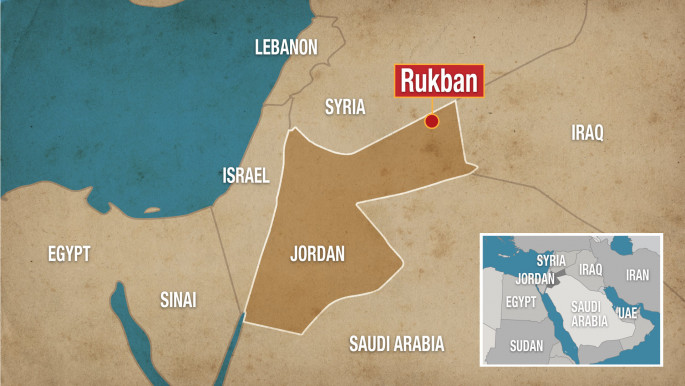Rukban camp IDPs refuse to use Russian 'humanitarian corridors' to Syrian regime areas
Desperate civilians trapped in the Rukban camp on the Syria-Jordan border have refused to leave using temporary "humanitarian corridors" opened by Russia and the Syrian regime on Tuesday.
The civilians fear arrest, torture and even death if they were to enter regime-held territory through the corridors.
"Not a single civilian has moved towards the corridors, because of the uncertainty of their destination after exiting the corridors," the Civil Administration of the Rukban Camp announced on Wednesday in a Facebook post.
The Russian Ministry of Defence claimed on Sunday the corridors were an opportunity for civilians to "voluntarily, unimpededly and safely" leave the camp.
The passages were opened unilaterally, without any negotiations with the Free Syrian Army or arrangements with the UN, and closed on Wednesday after being open for 24 hours.
The camp is located inside the al-Tanf "deconfliction zone" set up by the US-led international coalition in 2016. First set up to train opposition forces for the fight against the Islamic State group, the zone has since been described as a base for monitoring Iranian movements in Syria.
Syrian refugees in Rukban, fearing the regime overtaking the area following the US withdrawal from Syria, have called to be moved to opposition-held northern Syria before US troops leave Tanf.
"Will people return to the homes they have fled, or to new camps which the regime controls?" asked Omar Homsi, a media activist in Rukban.
Fellow media activist Imad Ghali added: "I am very sure that the majority of the camp residents do not want to return to regime-held areas."
Rukban residents have reason to fear crossing to regime-held areas. Russia's Ministry of Defence said on Sunday that, while checkpoints at the corridors would offer food, clothing, medical checkups and other vital support IDPs have been lacking, the "law enforcement agencies" of Syria would operate checkpoints and "escort" civilians to other destinations.
 |
We fled to an area where there is absolutely no life, just to get away from fighting and shelling |  |
Around 50,000 civilians live in the remote camp, most of them internally displaced people (IDPs) from Homs, Deir az-Zour, and Deraa. 80 percent of the residents are women and children.
Most residents in Rukban were forced to leave their homes due to Syrian regime and Russian aerial bombardment. With the vast majority of the country back under the hold of the regime, many IDPs fear arrest, torture and even death if they return.
"If we went to the ends of the earth, they would not leave us alone," Abu Yahya Jaber, an IDP from Homs in the camp, told The New Arab Arabic service.
"We fled to an area where there is absolutely no life, just to get away from fighting and shelling."
He said an expression had spread throughout the camp, recalling the reported detention of civilians leaving Eastern Ghouta and Deraa after ceasefire deals: "the choice is between death in Rukban and death in regime-held areas".
|
|
The desert camp has become increasingly isolated since Jordan sealed its border with Syria in 2016, after an Islamic State group militant attack on Jordanian border guards left seven officers dead. Jordan has said they will only allow the transfer of refugees through their territory who have received offers of resettlement.
IDPs have since been stranded on the frontier despite pleas for international assistance. Rukban residents have little access to clean water, food and medication, and face extreme weather conditions in both summer and winter. At least eight children have died this winter in Rukban according to UNICEF.
The first aid convoy to reach the desert camp in three months delivered aid in early February. Before a small aid convoy in November, the camp had not received any supplies for 10 months.
Such aid convoys are a temporary fix for residents trapped in the camp as the border with Jordan remains closed and IDPs appear to afraid to return to regime-held areas.
Ghali said that although he and others in the camp had heard the "Russian propaganda" about the corridors, no one had any idea how to reach them if they want to leave. In order to cross before Wednesday morning, Rukban residents would have add to travel over more than 50km of desert.
|
|
Despite commonly-held fears about regime repercussions, around 200 residents traveled to Maheen, a town in Homs, as part of an uncoordinated convoy in January, reported Syria Direct.
It remains to be seen whether access to the "humanitarian corridors" will be extended by the Syrian regime or Russia, whose state news outlet claimed that 23 people had crossed into regime-held areas on Tuesday night.
The camp is located inside a “deconfliction zone” set up by the US-led international coalition in 2016, which Washington saw as a strategic foothold while it launched offensive against the Islamic State, as well as being close to the Iranian weapons supply route entering Syria from Iraq.
However the desert camp has become even more isolated since Jordan sealed its border with Syria in 2016, after an Islamic State group militant attack on Jordanian border guards left seven officers dead, and causing refugees to be stranded on the frontier.
Due to the fluctuating conflict between numerous factions, access to the camp is often restricted due to security and logistical reasons.
Syria's civil war has killed more than 360,000 people and displaced millions since it started with the brutal repression of anti-government protests in 2011.





 Follow the Middle East's top stories in English at The New Arab on Google News
Follow the Middle East's top stories in English at The New Arab on Google News


